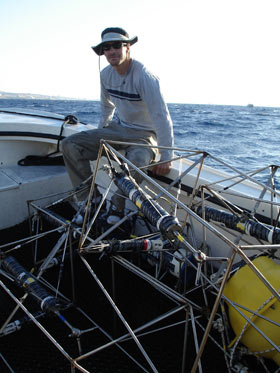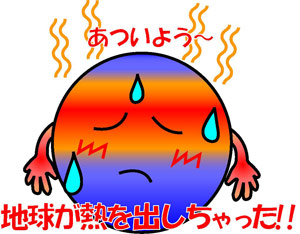by William Hooke, AMS Policy Program Director.
From the AMS project, Living on the Real World
Early in the Bush administration, sometime during the winter of 2001-2002, I got to sit in on a remarkable conversation. Three of us were meeting with the president’s new science advisor, John H. “Jack” Marburger, III, in his office. He was just getting his feet on the ground, and reaching out to different sectors of the science community. We were there to speak a bit to the contributions atmospheric science had made to the country, and how these contributions would not have been possible without steady government support, sustained for several decades. We weren’t there to ask for something; we were there to express thanks for past support, from both Republican and Democratic administrations.
At one point Jack invited us to each say something about the work of our respective organizations. I’d been at the American Meteorological Society only a year or so, and felt I’d rather say something about the work of our Education Program rather than my own policy interests. So I described how Ira Geer and his staff had constructed a wonderful Ponzi or pyramid scheme. Many science education programs focused on getting practicing scientists in the classroom; the idea has been that somehow these scientists could convey the excitement of the research bench. Some university faculty have proved better at this than others, but the results have been checkered at best. Ira and the AMS came at this from the opposite direction: public school teachers knew how to relate to the school kids; so why not give these teachers the resources they’d need to teach Earth science content? The AMS focused on reaching into the classrooms of education departments at universities and community colleges. They also chose to work closely, over a period of years, with a small cohort of public school teachers, who in turn would return home each year, and establish and maintain further cohorts (of cohorts) in their home states. In this way, Ira, his successor Jim Brey, and their staff of ten or so have reached 100,000 teachers and ten million students. Good numbers!
Marburger thought so too. He had been polite all along, but now grew animated, leaned forward. “American kids care about three kinds of science,” he said, “space, dinosaurs, and the weather.” He then recounted a story from his Brookhaven National Laboratory days. “We had an open house every year,” he said.
“One year, looking for ways to boost public attendance, we realized we had a National Weather Service Forecast Office on our [extensive] Brookhaven premises. We added them to our open house. The good news was that attendance shot way up! The bad news was everyone flocked to the Doppler radar. No one wanted to see our particle accelerators.”
What does this say? Public education in the Earth sciences provides the United States a badly-needed twofer. First, if educational statistics are leading indicators of the future place of the United States in the world, then our slippage relative to other countries in science, technology, engineering, and mathematics (STEM) education augurs poorly. More emphasis on Earth science education offers a way out of our dilemma. As kids are drawn into Earth science, they quickly realize they need to learn a little physics, a little chemistry, a little biology – and top it all off with some mathematics. That childhood fascination with snowflakes and winter storms; thunder and lightning, downpours, and rainbows; with hurricanes and tornados? Earth sciences tap into this. They are a portal, a doorway, inviting kids into the world of science and technology more broadly.
Second, these school kids, when they reach adulthood, are going to be consulted frequently, through polling, through the voting booth, through their daily viewing choices on television or websites about their environmental preferences. What do they want their elected officials and leaders to decide and do relative to resource use, environmental protection, land use, building codes, preservation of habitat and biodiversity? High school may be the last chance to many to obtain the educational grounding they’ll need to make wise choices.
Sadly, most state educational standards struggle to include Earth sciences in any robust way. The tendency is for Earth sciences to be crowded out by physics, chemistry, biology, and mathematics. Understandable! These subjects are basic – they offer great employment opportunities going forward, and many of the same political challenges. But ideally, educators would use Earth sciences curricula as bookends in the secondary schools. The Earth sciences should be introduced at some point in middle school, to motivate students to learn the science and mathematics that are coming through the rest of the high school years. But then it should be re-offered, at a greater level of complexity and thoroughness in the senior year, when students can see how the physics, chemistry, and biology that they’ve been learning come together in order to explain how the atmosphere, oceans, and land surface work.
Easier said than done? Absolutely. But worth it if we hope to sustain our quality of life on the real world.
education
Back to School
Welcome back to school, kids. It’s the first day that your teacher has set up this newfangled “interactive whiteboard” in your classroom. She isn’t sure what you and your fellow first graders are going to make of internet connectivity and videos and powerpoints.
But as a budding meteorologist, you know what to do:
So yes, Doppler radar and a brief weathercast for your 6-year-old classmates. Here’s how teacher Stephannie Waller tells it:
I have a student meteorologist for the week & this bright student saw that what was on the promethean board was what he saw every morning on our computer when he checked the weather, so he asked, “Can I check the weather on that?” Seeing that it was a very teachable moment & that he could teach every other student how to be a meteorologist I said yes. So he clicked it on & then I asked him to click on the Doppler Radar (it was raining this morning & they would actually have something to watch) & then asked him to enlarge it & from there he went to town, like a natural.
While there’s plenty of disagreement amongst educators and parents about the value of smart boards, there should be no disagreement that this kid has a good start on an application for his AMS certification.
"An Incredible Experience"
The AMS/UCAR Congressional Science Fellowship is a unique opportunity for scientists to become involved in the policy process on Capitol Hill. On Tuesday, the current AMS fellow and two former fellows gathered to discuss some of their experiences and dispense advice to potential applicants.
The 2009-10 AMS Congressional Fellow is Jonah Steinbuck, who received his Ph.D. in environmental fluid mechanics and hydrology from Stanford University in 2009. Steinbuck describes his work as a fellow for Representative Edward Markey (D-MA) in the Select Committee for Energy Independence and Global Warming as an “incredible experience.”
Steinbuck noted that he chose working with Markey and the Select Committee for a number of reasons: 1) because of his interest in climate policy and his belief that the Select Committee gave him the best opportunity to pursue that interest, 2) because “Chairman Markey is one of the leaders in environmental and energy issues,” and 3) because of the Select Committee staff, which allows him to be “a sponge absorbing information” from “some of the best climate policy talent on Capitol Hill.”

Perhaps the highlight of Steinbuck’s fellowship thus far was his recent trip to the Copenhagen Summit, where he received a credential from the State Department and was able to attend the talks. Steinbuck was particularly impressed with the dramatic conclusion when President Obama negotiated the final text of the agreement with other world leaders.
While the Select Committee awaits the final results of the conference, Steinbuck is also currently tracking EPA regulation of greenhouse gases while monitoring a number of bills proposed to block such regulation from stationary sources.
Past fellows Stephanie Herring and Michael Morgan also spoke about their Congressional Fellowship experiences. Herring, who like Steinbuck served under Congressman Markey in the Select Committee for Energy Independence and Global Warming, is currently working on climate science and service issues as a climate policy analyst in the office of the Department of the Deputy Undersecretary at NOAA. During her time as a fellow, Herring worked on the original version of the legislation that eventually became the Clean Energy and Security Act (also known as the Waxman-Markey Bill). She called the fellowship an ideal transition into new pursuits and in this clip responded to a question on how her fellowship experience enhanced her Ph.D. studies.
Morgan, currently a professor at the University of Wisconsin, recalled his time in Senator Benjamin Cardin’s (D-MD) personal office with fondness, even though, as he explained here, it was the exact opposite of what he originally thought he was looking for in a fellowship experience. Morgan explained that one of the most important things he learned on Capitol Hill was that “science is not enough”–senators must consider all their legislative priorities and their constituents’ priorities and determine how science fits into that framework.
The speakers cited numerous characteristics that Congressional Fellowship applicants should have: analytic skills, interpersonal skills, awareness of federal policy, an understanding of the role and limits of science in federal policy, diplomacy and political acumen, a sense of ethics, and perhaps most importantly, a legitimate interest in policy that has been displayed in their academic career. They noted that the competition for the fellowship is considerable and that the scientific records of most applicants is outstanding.
Applications for the 2010-2011 fellowship are due by February 10.
K-12 Education at Home and Abroad
The rewards of teaching the Earth sciences at the K-12 level in the United States are great, but sometimes so are the frustrations. At Monday’s education forum, Sandra Henderson touched on some of these issues in a discussion of recent UCAR surveys of K-12 Earth science teachers.
UCAR, which supports the professional development of science teachers through their “Windows to the Universe” website and other initiatives, generated almost 1,000 responses from National Earth Science Teachers Association (NESTA) members and newsletter subscribers. While making note of one particularly positive development–that teachers now have reasonably good access to technology and utilize it regularly–Henderson also listed the top 10 concerns of science teachers and summarized the surveys’ findings.
So how can these concerns be addressed? American educators might look to their colleagues across the Pacific for a uniquely successful approach to environmental education. In another forum presentation, Michihiko Tonouchi of the Japan Meteorological Business Support Center in Tokyo described a program in Japanese public schools that teaches students about global warming and other environmental issues.

Weather studies in Japan are now a compulsory subject for elementary school fifth-graders and those in their second year of junior-high school. In the program described by Tonouchi, approximately 100 broadcast meteorologists from the Weather Caster Network (WCN) and 300 engineers from Sharp share teaching responsibilities, with the broadcasters explaining basic scientific principles of global warming and the engineers discussing mitigation and adaptation strategies. Quizzes and hands-on experiments are an important part of the instruction. Along with global warming, alternative energy and recycling are also studied.
A website maintained in conjunction with the program provides a forum for student and teacher feedback, as well as activities, articles, and other resources. Tonouchi noted that both students and teachers have enthusiastically embraced the program, and said that the program’s organizers would like to expand the project to the U.S. and other parts of Asia.